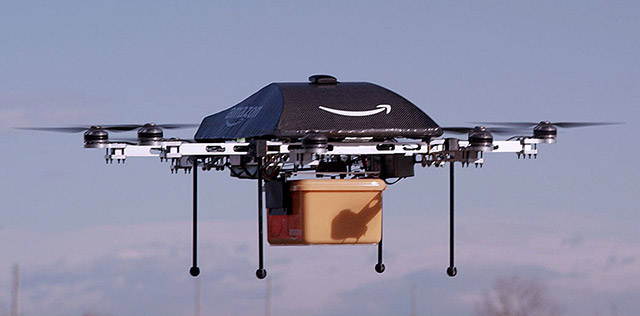We live in exciting times. Being only 112 years removed from the birth of the airplane puts us in the extraordinary position of living, at least in terms of epochs and ages, within a hair’s breadth of the dawn of flight. The second man to walk on the moon, the first to go faster than the speed of sound, the first civilians to fly around the world nonstop, and the first female and black pilots of a scheduled airline in the United States are all still with us. Shockingly, the latter two milestones didn’t happen until 1973.

Online retailer Amazon has plans to deliver packages via drone in its Amazon Prime Air program.
Given how fast things have moved from wood and fabric to turbines and carbon fiber, it’s tempting to assume that in another 100 years we’ll all be buzzing around in jetpacks and flying cars. But I don’t think so.
What we’re probably living in is a brief flash in time between the beginning of the airplane and the end of the pilot, at least in the way we think of him today. Jetpacks are too dangerous, flying cars too heavy, learning to fly a big commitment. The pilot is human, and humans make mistakes. Unmanned aircraft already keep an eye on our pipelines, monitor our crops, patrol our borders, and fight our wars. In the not-too-distant future they will transport our families and deliver our packages.
We are the golden age of flight. That’s both bittersweet and remarkable. When the Wright brothers flew for the first time, few believed manned flight was even possible. Now, a little more than 100 years later, aircraft are flying without pilots—and soon, they may put us out of business altogether. There’s something ironic about humans engineering ourselves out of the system, but in many cases it’s logical and prudent—which is not the same thing as fun and rewarding.
Don’t let this get you down. We’ve largely moved off the water for our transportation needs, but the sea remains captivating. The sky is no different. Although computers will fly our airlines and fight our forest fires, it’s hard to imagine the allure of flight will ever die. And no doubt the recreational aspect of flying, and the individual freedoms it provides, will endure. The thrill of being off the ground, seeing the world anew, does not waver. For many, the challenge of being the one who controls that experience will forever be there.
Our cover story this month is about that ultimate form of aircraft challenge and control. Flying aerobatics is as popular as ever, in part because it continues to provide a thrilling connection to the airplane. Writer Jim Moore talks to a national aerobatic champion and a once-scared pilot now obsessed with the hobby. The bottom line? Going upside down is fun, and a lot more exciting than flying a drone.



